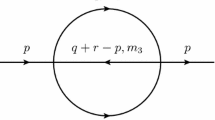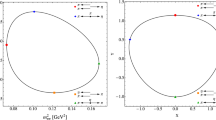Abstract
Using the recently proposed higher-order chiral Lagrangians determined from the integration of nontopological chiral anomalies, we calculate corrections to the current-algebra analysis ofK→3Π decay amplitudes expanded in powers of the Dalitz variables. Effects of quartic-derivative weak chiral Lagrangians are determined through the use of short-distance effective weak Hamiltonian and the factorization method. We find that (1) the constant and linear terms in the amplitude for ΔI=1/2K→3Π are in excellent agreement with experiment; the previous discrepancy of (20–35)% between current algebra and data is thus accounted for by the higher-order effective Lagrangians, (2) the penguin interaction does not play an essential role in the ΔI=1/2 rule, for otherwise it will lead to a large disagreement for the constant and linear terms, (3) one of the two quadratic terms in the ΔI=1/2 process, which arise from the quartic chiral Lagrangians, is in accord with data within experimental errors, while the other is off by four standard deviations, (4) the linear term in the ΔI=3/2 transitions is in good agreement with experiment and contributions from quadratic terms are sizable.
Similar content being viewed by others
References
J.A. Cronin: Phys. Rev. 101 (1967) 1483
T.J. Devlin, J.O. Dickey: Rev. Mod. Phys. 51 (1979) 237
E. Golowich: Phys. Rev. D35 (1987) 2764; ibid. E. Golowich: Phys. Rev. D36 (1987) 3516
J.F. Donoghue, E. Golowich, B.R. Holstein: Phys. Rev. D30 (1984) 587
H.Y. Cheng, C.Y. Cheung, W.B. Yeung: Mod. Phys. Lett. A4 (1989) 869
J.S.R. Chisholm: Nucl. Phys. 26 (1961) 469
C. Bernard et al.: Phys. Rev. D32 (1985) 2343
K.C. Chou, H.Y. Guo, K. Wu, X.C. Song: Phys. Lett. 134B (1984) 67; G.C. Rossi, M. Testa, K. Yoshida:ibid.Phys. Lett. 134B (1984) 78; H. Kawai, S.-H. Tye: ibid. Phys. Lett. 140B (1984) 403; A. Dhar, S.R. Wadia: Phys. Rev. Lett. 52 (1984) 959; J.L. Petersen: Acta Phys. Pol. B16 (1985) 271; Ö. Kaymakcalan, S. Rajeev, J. Schechter: Phys. Rev. D30 (1984) 594; N.K. Pak, P. Rossi: Nucl. Phys. B250 (1985) 279
J. Balog: Phys. Lett. 149B (1984) 197; R.I. Nepomechie: Ann. Phys. (N.Y.) 158 (1984) 67; K. Seo: Gifu Report No. GWJC-1, 1984 (unpublished); A.A. Andrianov: Phys. Lett. 157B (1985) 425; see also D. Ebert, H. Reinhardt: Nucl. Phys. B271 (1986) 188
R. Mackenzie, F. Wilczek, A. Zee: Phys. Rev. Lett. 53 (1984) 2203; I.J.R. Aitchison, C.M. Fraser: Phys. Lett. 146B (1984) 63; G. Bhattacharya, S. Rajeev: in Proceedings of the Sixth Annual Montreal-Rochester-Syracuse-Toronto Meeting, Syracuse, 1984 Syracuse, New York: Syracuse University 1984; P. Simic: Phys. Rev. Lett. 55 (1985) 40; L.H. Chan: ibid. Phys. Rev. Lett. 55 (1985) 21; A. Zaks: Nucl. Phys. B260 (1985) 241
H.Y. Cheng: Phys. Rev. D36 (1987) 2056. The form factorf+(t) of the matrix element, say\(\left\langle {\pi ^ - |\bar s\gamma _\mu u|K^0 } \right\rangle \), is often expressed as (1+t/Λ 2). From the quartic-derivative LagrangianL (4) S , it is easy to check that Λ=2πf π. This scale is consistent with the upper bound\(2\sqrt 2 \pi f_\pi \) estimated by Manohar and Georgi [12]
A. Manohar, H. Georgi: Nucl. Phys. B234 (1984) 189
J. Gasser, H. Leutwyler: Nucl. Phys. B250 (1985) 465
J. Balog: Nucl. Phys. B258 (1985) 361
H.Y. Cheng: Phys. Rev. D34 (1986) 166
A.A. Bel'kov, A.V. Lanev: Sov. J. Nucl. Phys. 45 (1987) 312
A.A. Bel'kov, D. Ebert, V.N. Pervushin: Phys. Lett. 193B (1987) 315
L.F. Li, L. Wolfenstein: Phys. Rev. D21 (1980) 178
H.Y. Cheng: J. Mod. Phys. A4 (1989) 495
A.I. Vainshtein, V.I. Zakharov, M.A. Shifman: Sov. Phys. JETP 45 (1977) 670
L. Rosselet et al.: Phys. Rev. D15 (1977) 574
T.N. Pham: Phys. Lett. 145B (1984) 113; H.Y. Cheng: Phys. Rev. D36, (1986) 2056
It should be stressed that (4.16) is valid only under the factorization assumption
J.F. Donoghue, B.R. Holstein, G. Valencia: Phys. Rev. D36 (1987) 798
S. Weinberg: in I.I. Rabi Festschrift, New York Acad. of Sci. (N.Y.) (1978); J. Gasser, H. Leutwyler: Phys. Rep. 87 (1982) 77
C.T. Hill, G.G. Ross: Phys. Lett. 94B (1980) 234
J. Donoghue, E. Golowich, W. Ponce, B. Holstein: Phys. Rev. D21 (1980) 186
Various conjectures and speculations about the origin of the ΔI=1/2 rule are discussed in [19]
Author information
Authors and Affiliations
Rights and permissions
About this article
Cite this article
Cheng, HY., Cheung, C.Y. & Yeung, W.B. Analysis ofK→3Π decays in chiral perturbation theory. Z. Phys. C - Particles and Fields 43, 391–400 (1989). https://doi.org/10.1007/BF01506534
Received:
Revised:
Issue Date:
DOI: https://doi.org/10.1007/BF01506534




